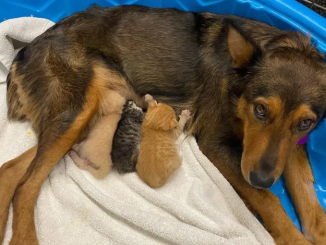
In 2007, a dark chapter in the world of animal cruelty came to light when authorities rescued 51 Pit Bulls from the Virginia home of Atlanta Falcons quarterback Michael Vick. These innocent animals had endured unimaginable abuse, subjected to beatings, electrocutions, hangings, drownings, and forced dogfights.
Out of this horrific ordeal, 48 resilient Pit Bulls emerged as survivors, thanks to the dedication of several rescue organizations and their forever families. One of these survivors, Frodo, recently passed away at the age of 15 on December 18th, 2021. Frodo’s journey serves as a testament to resilience, second chances, and the unwavering commitment of those who fight for justice and rehabilitation.

Frodo’s life was a stark contrast to the year he spent in hell at Michael Vick’s compound. Once rescued, he was embraced by a loving family and pampered like a prince for the next 14 years. His passing left a void in the hearts of those who knew and cared for him, particularly BAD RAP, an Oakland-based nonprofit animal protection group that played a pivotal role in advocating for and rehabilitating the Vick dogs.

In a touching Facebook post, BAD RAP bid farewell to Frodo: “To Frodo – We all adored him. He was one of the most valiant survivors we’d ever met.” His passing was peaceful, surrounded by the love of his family, who ensured his final moments were filled with comfort and care.

Frodo’s journey wasn’t just a personal triumph; it became a symbol of hope and resilience for Pit Bulls and dogs with difficult pasts everywhere. BAD RAP, with its extensive experience in working with dogs rescued from dogfighting rings, always believed in the potential for these dogs to be rehabilitated and reintegrated into loving homes.
Frodo’s story dispelled the negative stereotypes associated with Pit Bulls and underscored the transformative power of patience and kindness in a dog’s life. He exemplified the importance of early socialization for dogs rescued from cruelty incidents, showing that with the right environment and loving care, even the most timid and scarred animals can thrive.

Kim Ramirez, Frodo’s adoptive mother, shared insights into his journey, explaining how mechanical sounds and sudden movements used to terrify him. She described the challenges of helping Frodo overcome his past trauma, such as his fear of ceiling fans and microwave popcorn, which likely reminded him of the traumatic events he had witnessed.

Throughout his life, Frodo enjoyed the devoted care of the Ramirez family, who accommodated his needs, including transporting him in a stroller when his legs began to fail. His story was a testament to the healing power of love and the resilience of animals.

Frodo’s passing is a reminder of the enduring legacy of the 48 survivors of Michael Vick’s dogfighting ring. These brave dogs were given the opportunities they deserved, and despite their challenging backgrounds, they lived happy lives, proving that remarkable transformations are possible with compassion and commitment.
While Michael Vick’s actions were reprehensible, the high-profile case did raise awareness about dogfighting and its devastating consequences. It also shifted public perception of Pit Bulls, showcasing their potential for rehabilitation and adoption. Frodo and his fellow survivors are living proof that even in the darkest of circumstances, there is hope for a brighter future.

As we bid farewell to Frodo, we honor his memory and the countless animals who have found their second chance at life through the dedication of animal rights activists and the kindness of loving families. Frodo’s story will continue to inspire us to fight for justice, compassion, and a world where every animal can thrive.
Dedicated Father: Golden Retriever Displays Remarkable Commitment in Caring for His Pregnant Mate.
For dads, do you recall how you took care of your wife while she was pregnant?
Of course, you do. You could have recalled those moments when you conducted errands while being the only one who was in charge of the house and all the chores. Well, you’re not alone.
While some spouses will say that they weren’t as lucky, they can always display this viral film of how a golden retriever took care of his mate while in delivery.

These Goldens went viral. At first, they were seen sleeping next each other. Then, the instant the wife woke up, the dog rushed for the AC switch and upped the temperature.
Next, he snatches a tiny basin with his mouth and trots to the kitchen. He set the basin down in the sink and stretched his paw to turn on the faucet. He then gladly marched to his mate, quite happy with himself.
Once she finished her drink, he went to retrieve her leash. As a pregnant dog, exercise is still vital so she may keep fit. But instead of their owner taking both of them to the park, the dog chewed on the leash and joined his mate.

This provided the daddy dog an opportunity to conduct other errands. Throughout this section of the day, he went into the kitchen to assist prepare his mate’s dinner.
Chicken, fish, shrimp, and some veggies seem excellent. Daddy dog assisted his human with cleaning. He even took out the garbage.

He’s even a gentleman during dinner. He could be incredibly hungry with all his effort, but he lets his mate get her fill first. After all, she’s also eating for their pups.
Later, when he invited her for a post-dinner run, something occurred. His wife urged to remain home.
Then, the labor began. As their fur parents sensed what was about to happen, they swiftly prepared up a nest for her. What was a room only for the two of them became a home for a loving family.

One by one, the puppies emerged from their mother. The owners cleaned them well before leaving them to breastfeed on their mother.
All the while, they were feeding her readily digested meals to aid her through the procedure.
The adorable retriever eventually became daddy. They ended up with seven healthy pups. They all have their unique colorful collars that nearly resemble a rainbow.
And just like that, the daddy dog is on the chores again. But this time, he wasn’t simply taking care of one dog. He’s watching over his mate and their children.

With the reliability that this “goodest” youngster displayed, though, we know they’ll be okay.
See this doting golden retriever take care of his complete family in the video below!

Kindly SHARE this with your friends and family.



Leave a Reply